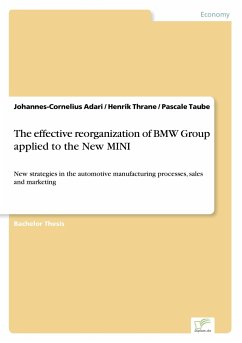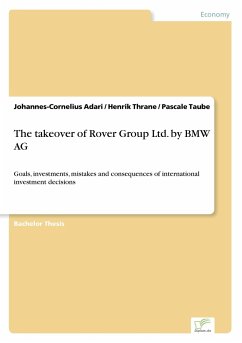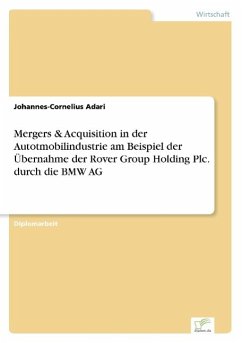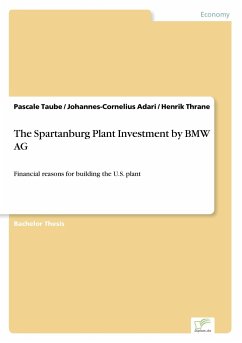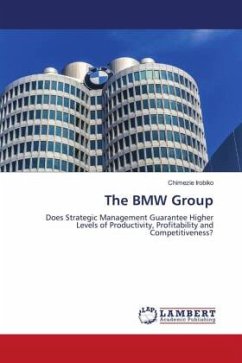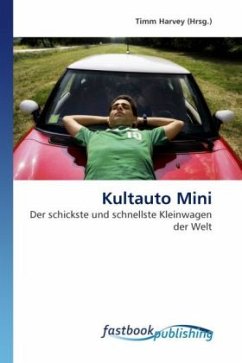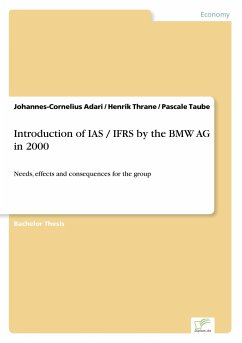Bachelor Thesis from the year 2003 in the subject Business economics - Supply, Production, Logistics, grade: 1,9, Hogeschool Zeeland (Economics), language: English, abstract: Inhaltsangabe:Abstract:
The story of the automobile manufacturer production can not be told without the story of Henry Ford, who was one of the pioneers constructing his first horseless carriage in 1896.
He incorporated the Ford Motor Company in 1903, proclaiming I will build a car for the great multitude . As predicted he did so in 1908 offering a Model T for $ 950. This model heralds the beginning of the motor age. The car evolved from a former luxury item for the well-to-do to essential transportation for the ordinary man.
Ford also revolutionized automobile manufacturing, in 1914 the Ford plant used innovation production techniques and was able to turn out a complete chassis every 95 minutes. That was a revolution in the automobile manufacturing at the time, because the former production time took about 730 minutes to turn out a complete chassis! Ford achieved that fast production time by using a constantly moving assembly line, subdivision of labor, careful coordination of operations and he began to pay nearly double the wages offered by their competitors.
His innovations made him an international celebrity in the industrial revolution and he was one of the first who thought about effective organization to achieve a higher productivity.
Ford s methods that changed the automobile production were perhaps not mainly the introduction of the assembly line, his goal was also to constantly standardizing the use of craftsmen. That firstly resulted in a high product variety despite in fact that they had been made using the same drawing. Secondly a lot of time was spent in fitting the parts together. These facts influenced major loss in productivity and under such circumstances a real mass-production was not possible. But by standardizing components and developing work routines was the first scope for an assembly line approach.
The target of our case study is to present and analyze the changes in companies organizations, applied to the example of BMW.
The opening part will summarize the history of the working and organizing techniques in general. The middle part will focus on the changes in production organization in the automotive industry, followed by the last part analyzing new strategies in Sales & Marketing regarding the rebirth of MINI by the BMW Group.
Zusammenfassung:
Die vorliegende englischsprachige Projektarbeit behandelt das Thema effektive Reorganisation in Produktion, Vertrieb und Marketing in der Automobilindustrie am Beispiel der Markteinführung des neuen MINI durch die BMW AG.
Nach der gescheiterten Übernahme der Rover Group trennte sich BMW im Jahr 2000 von allen Rover-Marken, mit Ausnahme des Mini. Während Land Rover an Ford und Rover Cars an das Phoenix Konsortium verkauft wurde, sollte der Mini völlig neu überarbeitet und international in das Segment der Premium-Kleinwagen eingeführt werden.
Ziel der Arbeit ist es, die Zielvorgaben und die betriebswirtschaftlichen Auswirkungen von Reorganisationen und Produkterneuerungen durch Anwendung neuer Strategien und Einführung neuer Produkte in den Bereichen Produktion, Vertrieb und Marketing am Beispiel des MINI aufzuzeigen.
Die Arbeit ist in 4 Teile untergliedert. Im 1. Teil wird die Entwicklung der Arbeits- und Produktionstheorien von der Industrialisierung bis zur heutigen Massenproduktion beleuchtet.
Anschließend werden im 2. Teil moderne Methoden aus der Produktion wie z.B. Lean Production und Total Quality Management skizziert und im 3. Teil auf den aktuellen Stand der Produktions- und Verkaufsorganisation bei BMW erweitert.
Der 4. Teil behandelt den Relaunch des neuen MINI innerhalb der Premium-Markenstrategie im BMW-Produkt- und Markenportfolio sowie die Maßna...
Hinweis: Dieser Artikel kann nur an eine deutsche Lieferadresse ausgeliefert werden.
The story of the automobile manufacturer production can not be told without the story of Henry Ford, who was one of the pioneers constructing his first horseless carriage in 1896.
He incorporated the Ford Motor Company in 1903, proclaiming I will build a car for the great multitude . As predicted he did so in 1908 offering a Model T for $ 950. This model heralds the beginning of the motor age. The car evolved from a former luxury item for the well-to-do to essential transportation for the ordinary man.
Ford also revolutionized automobile manufacturing, in 1914 the Ford plant used innovation production techniques and was able to turn out a complete chassis every 95 minutes. That was a revolution in the automobile manufacturing at the time, because the former production time took about 730 minutes to turn out a complete chassis! Ford achieved that fast production time by using a constantly moving assembly line, subdivision of labor, careful coordination of operations and he began to pay nearly double the wages offered by their competitors.
His innovations made him an international celebrity in the industrial revolution and he was one of the first who thought about effective organization to achieve a higher productivity.
Ford s methods that changed the automobile production were perhaps not mainly the introduction of the assembly line, his goal was also to constantly standardizing the use of craftsmen. That firstly resulted in a high product variety despite in fact that they had been made using the same drawing. Secondly a lot of time was spent in fitting the parts together. These facts influenced major loss in productivity and under such circumstances a real mass-production was not possible. But by standardizing components and developing work routines was the first scope for an assembly line approach.
The target of our case study is to present and analyze the changes in companies organizations, applied to the example of BMW.
The opening part will summarize the history of the working and organizing techniques in general. The middle part will focus on the changes in production organization in the automotive industry, followed by the last part analyzing new strategies in Sales & Marketing regarding the rebirth of MINI by the BMW Group.
Zusammenfassung:
Die vorliegende englischsprachige Projektarbeit behandelt das Thema effektive Reorganisation in Produktion, Vertrieb und Marketing in der Automobilindustrie am Beispiel der Markteinführung des neuen MINI durch die BMW AG.
Nach der gescheiterten Übernahme der Rover Group trennte sich BMW im Jahr 2000 von allen Rover-Marken, mit Ausnahme des Mini. Während Land Rover an Ford und Rover Cars an das Phoenix Konsortium verkauft wurde, sollte der Mini völlig neu überarbeitet und international in das Segment der Premium-Kleinwagen eingeführt werden.
Ziel der Arbeit ist es, die Zielvorgaben und die betriebswirtschaftlichen Auswirkungen von Reorganisationen und Produkterneuerungen durch Anwendung neuer Strategien und Einführung neuer Produkte in den Bereichen Produktion, Vertrieb und Marketing am Beispiel des MINI aufzuzeigen.
Die Arbeit ist in 4 Teile untergliedert. Im 1. Teil wird die Entwicklung der Arbeits- und Produktionstheorien von der Industrialisierung bis zur heutigen Massenproduktion beleuchtet.
Anschließend werden im 2. Teil moderne Methoden aus der Produktion wie z.B. Lean Production und Total Quality Management skizziert und im 3. Teil auf den aktuellen Stand der Produktions- und Verkaufsorganisation bei BMW erweitert.
Der 4. Teil behandelt den Relaunch des neuen MINI innerhalb der Premium-Markenstrategie im BMW-Produkt- und Markenportfolio sowie die Maßna...
Hinweis: Dieser Artikel kann nur an eine deutsche Lieferadresse ausgeliefert werden.

